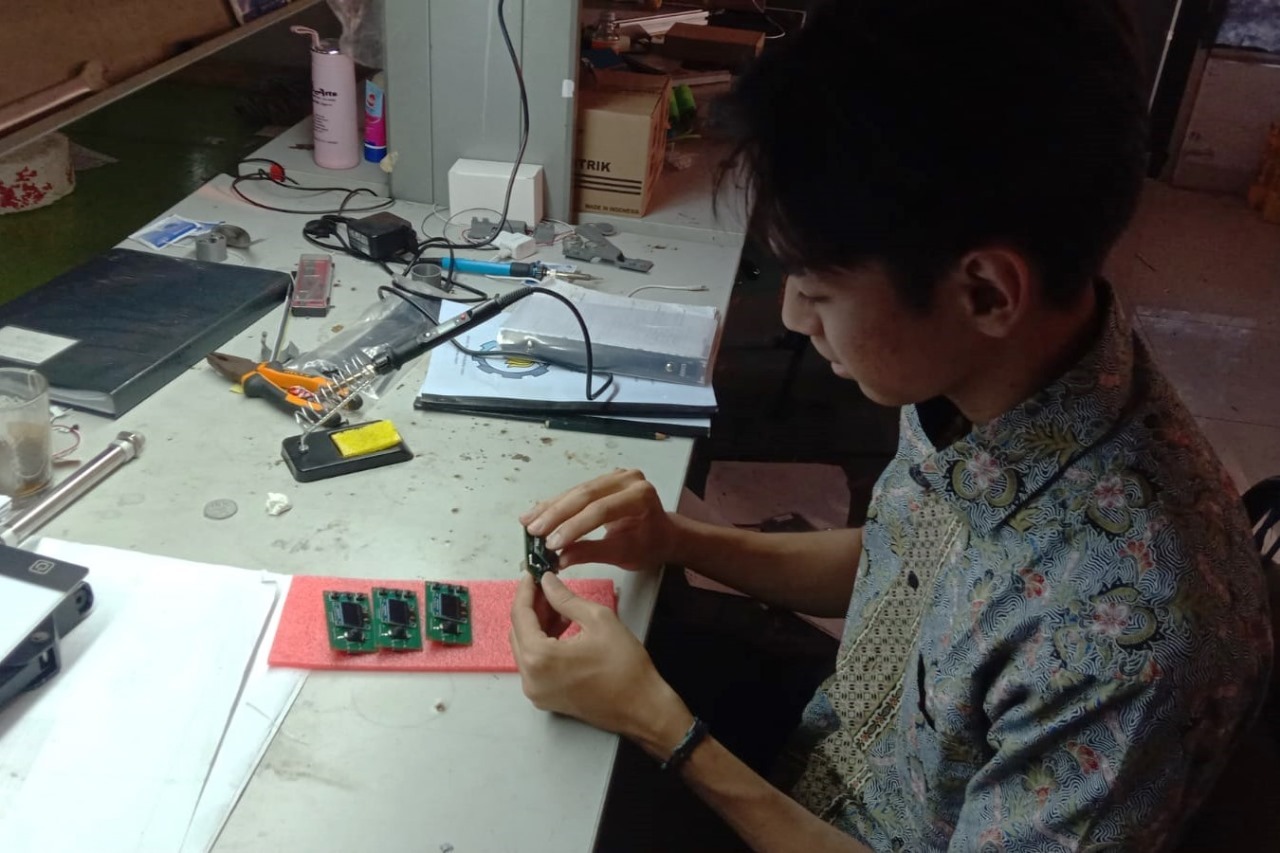ITS Students Initiate a Hemoglobin Detector with Embedded Artificial Intelligence

The members of the ITS Hemoglobest Team, while conducting preliminary testing on a non-invasive hemoglobin detector
ITS Campus, ITS News – One type of autoimmune disease is lupus, which can cause harmful effects when patients experience anemia. Hence, the student team from Institut Teknologi Sepuluh Nopember (ITS) initiates a non-invasive hemoglobin detector to measure hemoglobin levels and predict the likelihood of anemia with the help of artificial intelligence.
The development of a non-invasive hemoglobin detector called Hemoglobest by adding STM32 artificial intelligence. With artificial intelligence, this device can do calculations efficiently, thus accelerating the prediction of anemia conditions. The STM32 artificial intelligence can also save power and function as a microcontroller.
This hemoglobin detector designed by the ITS Hemoglobest Team can later be specialized to detect and predict anemia in patients with Systemic Lupus Erythematosus (SLE). Lupus patients require a specific approach to detect anemia, as their hemoglobin levels tend to be lower compared to non-lupus patients.

A hemoglobin detector designed by the ITS Hemoglobest Team, a device for detecting and predicting anemia, which can be specifically for lupus patients
The leader of ITS Hemoglobest Team, Muhammad Taufiqul Huda, explained that anemia in lupus patients potentially damages the cell structure of the body’s organs. It can happen as changes in hemoglobin levels in normal human blood are not as drastic as those in lupus patients. “This device is equipped with an anemia prediction system, so it can be used by lupus patients as an early warning,” he explained.
Unlike usual hemoglobin detectors, the ITS student’s idea of a detector uses a non-invasive procedure. This procedure refers to a medical procedure that does not require inserting an instrument through an incision in the skin, so it does not injure the skin. “Therefore, the device will be easier to use and will not cause pain,” the student, who is also part of the ITS Banyubramanta robotics team, said.

Revelyno Rellert Towidjojo, one of the members of the ITS Hemoglobest Team, while assembling the Hemoglobest compartment, a hemoglobin detector device designed by his team
On the other hand, the young man, who is familiarly called Huda, explained that this device uses five light spectrums, which will later be absorbed by hemoglobin in the blood vessels of the fingertips. “This also makes the detection results more effective compared to oximeters, which only use two spectrums,” this Electrical Engineering Department student explained.
To determine hemoglobin levels through the device, Huda continued, the incoming light spectrum will later be received by sensors within the device and analyzed for patterns in each spectrum. After the analysis is performed, the hemoglobin levels, both carrying oxygen and not carrying oxygen, will come out. From there, the hemoglobin levels and predictions of anemia can be observed.

The ITS Hemoglobest Team during a team meeting and consultation with their supervisor, Astria Nur Irfansyah ST MEng PhD (right)
Non-invasive hemoglobin detectors have been proven to produce less waste than invasive hemoglobin detectors. The use of non-invasive devices will reduce the amount of medical waste produced, such as test strips and disposable equipment used in invasive procedures. “The existence of this device will certainly reduce the amount of medical waste in Indonesia,” he added.
Owing to the full dedication of all team members guided by Astria Nur Irfansyah ST MEng PhD, a lecturer from the Electrical Engineering Department at ITS, the development of this hemoglobin detector has been successfully achieved. Amazingly, the Student Creativity Program in the field of Creative Initiatives (PKM-KC) group successfully won a silver medal in the Presentation category at the 36th National Student Scientific Week (Pimnas) in 2023. (ITS Public Relations)
Reporter: Muhammad Rizky Putra Wahyuana
Translator: Alya Farah Nabila
Related News
-
ITS Wins 2024 Project Implementation Award for Commitment to Gender Implementation
ITS Campus, ITS News —Not only technology-oriented, Institut Teknologi Sepuluh Nopember (ITS) also show its commitment to support gender
January 29, 2024 14:01 -
ITS Professor Researched the Role of Human Integration in Sustainable Architecture
ITS Campus, ITS News –The developing era has an impact on many aspects of life, including in the field
January 29, 2024 14:01 -
ITS Sends Off Group for Joint Homecoming to 64 Destination Areas
ITS Campus, ITS News — Approaching Eid al-Fitr, the Sepuluh Nopember Institute of Technology (ITS) is once again facilitating academics who want
January 29, 2024 14:01 -
ITS Expert: IHSG Decline Has Significant Impact on Indonesian Economy
ITS Campus, ITS News — The decline in the Composite Stock Price Index (IHSG) by five percent on March 18,
January 29, 2024 14:01
